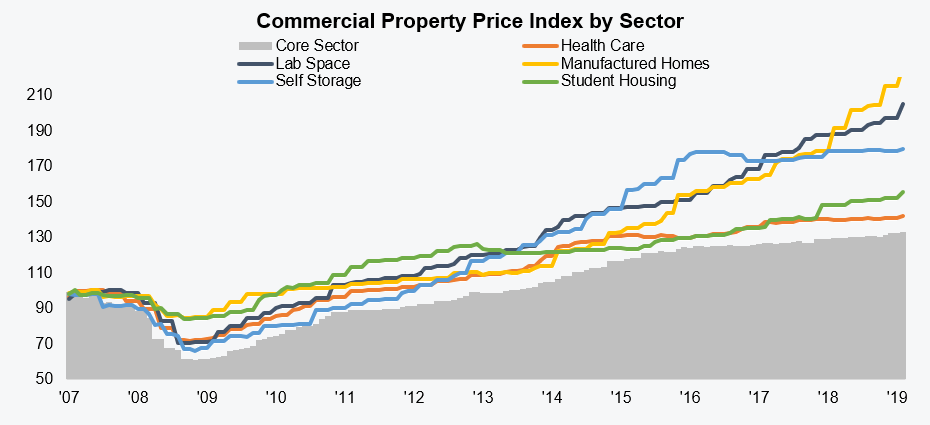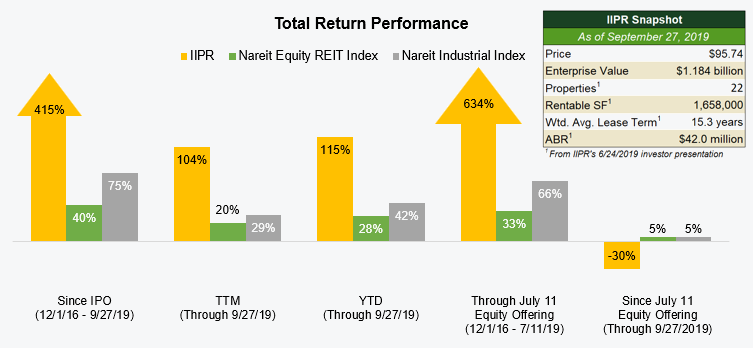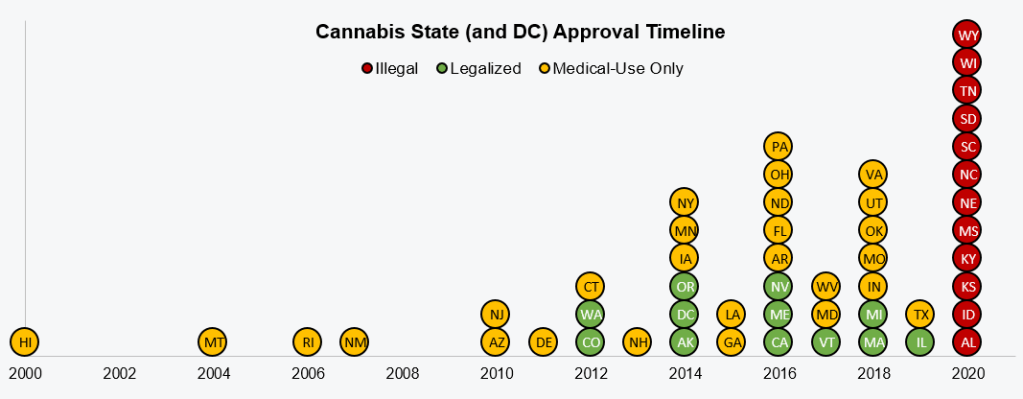Cannabis-Related Real Estate: The Next Emerging Property Sector?
Non-Traditional Sector Momentum
New commercial real estate sectors typically emerge as the result of a change, which may include new technology (e.g., data centers), new demographic trends (e.g., single-family rental), or new political policies (e.g., health care). Since 2008, investors have driven up pricing in the more established non-traditional sectors, including health care, lab space, manufactured homes, self-storage, and student housing, to new high watermarks. Meanwhile, the traditional core property sectors - office, apartment, retail, and industrial - have notably lagged their non-traditional peers.
 Source: Green Street Advisors
Source: Green Street AdvisorsStrong fundamental growth and heightened interest from institutional investors in the non-traditional sectors has fueled their outperformance. Institutional investors may initially be reluctant to invest in newer sectors due to mandates that limit investments to property types with more established markets perceived to offer greater liquidity. Because performance has been so strong however, investors who previously ignored these sectors have been forced to amend their mandates and allocate capital to the higher yielding non-traditional sectors. This institutional acceptance is one of two prominent periods of outperformance that investors realize when investing in a successful new sector. The other factor contributing to outperformance is commonly known as the “first mover advantage.” Initial or early investors can reap outsized returns, or a reward for investing in an unknown and perceived riskier industry. As additional investors enter the market and compete for market share, prices increase, thus driving returns lower until an equilibrium at an appropriate risk-adjusted market return is reached.
The first mover advantage can be observed in the recent significant outperformance of Innovative Industrial Properties, Inc. (IIPR), a real estate investment trust (REIT) that owns cannabis-related specialized industrial assets.
The First Cannabis REIT Enters the Market
IIPR, which began trading on December 1, 2016, focuses on specialized industrial and greenhouse buildings leased to state-licensed medical-use cannabis growers. The company’s management team identified states with approved medical-use laws that they believe are not under threat of any sort of regulation risk. IIPR serves as the lone NYSE-traded REIT option for investors looking to add exposure to cannabis-related industrial properties. After its public listing, shares labored in the market for the first 12 months. However, the story has changed dramatically since then.
 Source: Bloomberg
Source: BloombergFrom inception through July 11, 2019, the market rewarded IIPR investors with a cumulative total return of 634%. Over this same time period, the Nareit All Equity REIT Index posted a 33% total return, and the Nareit industrial total return index gained 66%. Americold, a non-traditional REIT specializing in cold storage warehouse properties, was the next best performing REIT over this time period, realizing a total return of 125%.1
Americold’s performance following its public offering illustrates the first mover advantage, but also points to the importance of disclosure and corporate governance. The company attempted and failed to publicly list in 2010. While the state of the capital markets at that time may have hurt Americold’s listing chances, poor disclosure surrounding capital expenditures within the sector and poor corporate governance sealed the company’s fate for a failed initial public offering (IPO). More recently, Green Street’s Advisory Group acted as an independent strategic advisor to Americold ahead of its second listing attempt. In early 2018, the IPO was a complete success. Not only were market conditions favorable with a healthy appetite for a first mover in a non-traditional sector, but thoughtful investor messaging was also critical to its success. This included sufficient disclosure of sector best practices, effective storytelling of Americold’s strategy, and vast improvements in the company’s corporate governance structure.
Despite IIPR’s drastic outperformance over the last few years, the company underperformed other public equity REITs by 35% from July 11 through September 27, 2019. It begs the question, what happened in July? The shift began July 12, 2019, when the company announced an equity issuance at its all-time high price. It is difficult to analyze this period of underperformance. That being said, the accelerating legalization of medical and recreational-use of cannabis at the state-level appears to have driven positive results up until July.
Since IIPR’s public listing at the end of 2016, 12 states have legalized approvals for either medical-use or recreational-use cannabis in their jurisdictions.2 The company traded up by at least 20% in the 30 trading days immediately following four out of these six approval periods. Not coincidentally, the four periods that witnessed this strong performance involved states with large populations. The stock performed best after the two largest groups legalized use: in November 2018, when Michigan, Utah, Massachusetts and Missouri adopted policy (accounting for 8% of the U.S. population), and in mid-2019, when Illinois and Texas joined their peers (representing nearly 13% of the country’s population).3
 Source: Bloomberg; DISA Global Solutions; MPP
Source: Bloomberg; DISA Global Solutions; MPPThe policy tailwinds are not necessarily over, however. Approximately 15% of the U.S. population resides in states where both medical and recreational cannabis use remains illegal. Demand should also increase as the historical “taboo” of cannabis wears off, and as the younger age cohorts grow in numbers and make up a larger percentage of the population. Furthermore, it is worth noting that IIPR has posted strong historical performance without any federal policy support.
Regulatory Backdrop: Still a Gray Area
Medical-use cannabis was legalized for the first time in Hawaii in 2000, and it is now legal in 38 states and the District of Columbia. Despite the seemingly extended timeline since the first approval, state policies that adopt either recreational or medical use have gained momentum.
 Source: DISA Global Solutions; MPP
Source: DISA Global Solutions; MPPThe merits of medical-use cannabis appear solid and well-enough entrenched that it is unlikely for federal policy to overturn its use. States appear willing to accept the risks of recreational-use as long as they participate in the profits. Washington, the second state to legalize recreational-use, levies a 37% sales tax on all recreational cannabis sales. Illinois, one of the most overindebted states, legalized recreational-use cannabis and attached a sales tax that can reach 32%.
Despite the lack of support, the federal government can still tax the sale of cannabis up and down the supply chain. Today, the federal government classifies cannabis as a Schedule 1 drug, the most restrictive category within the Controlled Substances Act. This classification enables the federal government to tax the sale of cannabis at a higher rate. It also increases the difficulty to raise capital to fund expansion on both the debt and equity side. Despite the additional regulatory scrutiny and heightened political risk, this young sector should continue to grow, albeit at a more moderate pace.
Green Street’s Advisory Group provides independent guidance to owners and investors around the globe. The team closely follows emerging market trends, including non-traditional sectors and commercial property types that have not yet institutionalized. Opportunity exists for these companies to attract capital and outperform comparable alternative investments, especially in the current market environment where real estate across many sectors is pricey and investors are struggling to find attractive risk-adjusted returns. However, the path to success requires optimizing strategy, structure, and communications to maximize value and assume a “best-in-class” position in the marketplace.
Learn more about how Green Street’s Advisory Group helps build better companies.

Related Resources:
Learn more about our insights
Our thought leadership helps thousands of clients make better investment decisions every day. Inquire here to learn more about Green Street’s product suite.
More Stories
Retail Sector
Powering Retail Strategies: Trade Area Power Scores Launch in the UK Market
Retail Sector
London's Luxury Retail Playground: The Transformation of New Bond Street
Retail Sector